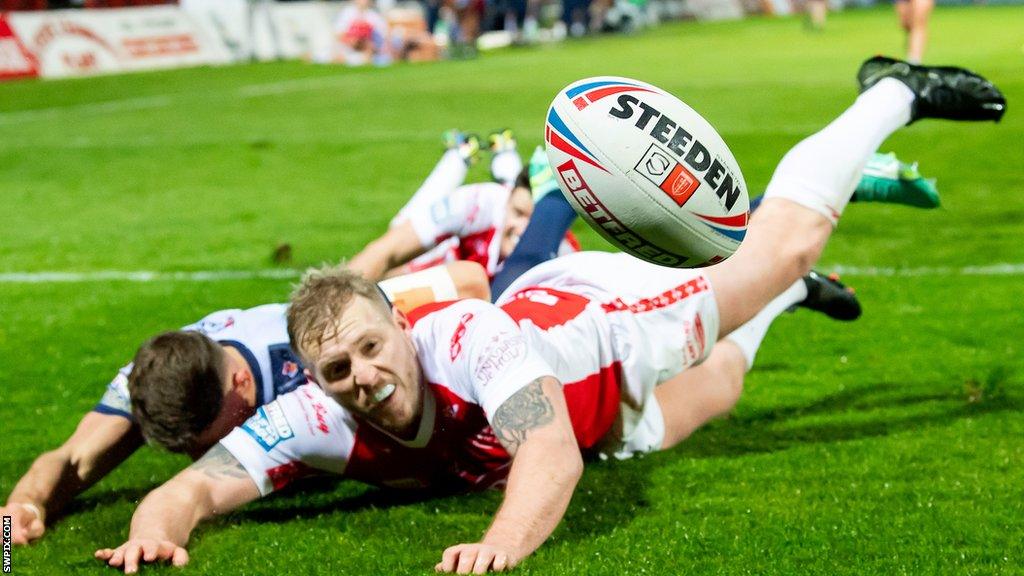British rugby league clubs in top three tiers vote in favour of grading proposal
- Published

Clubs will be racing to meet the right criteria for 2025, when the grading system will start
Clubs in the top three tiers of British rugby league have voted in favour of IMG's proposed club grading, which will see each team rated for various on and off-field performance criteria.
The proposal won with an 86% majority across the eligible teams from Super League, Championship and League One.
Currently, promotion and relegation via on-field performance decides placings.
The proposed new set-up, now voted in, will create a new top flight from 2025, guided by a variety of metrics.
The move is part of media giant IMG's strategic partnership with Rugby League Commercial, under the banner of 'Reimagining Rugby League'.
How will it work?
From the end of this season, all clubs in the professional game will be reviewed and given a grade based on the following criteria, with a maximum 20 points on offer.
Fandom [5 points]: Taking in attendances, memberships and digital engagement with fans
Performance [5pts]: Teams rated 1-36 in terms of league position over three seasons, with bonuses for league/cup wins
Finances [4.5 pts]: Income, financial stability, diversity of revenue streams and business performance
Stadium [3pts]: Quality of facility, match-day experience, capacity, utilisation
Community [1pt for foundation, 1.5pts for catchment area]: Success of foundations as charitable arms, and how much competition for supporters in local area.
To achieve a grade A ranking, clubs must score 15 points or higher and 7.5 to receive a B grading.
These base-level rankings will be delivered to give teams a full campaign to work on areas for improvement before the gradings count for real in 2025.
From 2025, the Super League - the top tier of rugby league which consists of 12 clubs - will be filled with all the category A clubs, with the remaining spots going to the best performing category B teams.
These categories will be assessed on an annual basis, offering clubs outside the elite division a chance to gain promotion by improving their variables in addition to on-field performance.

Analysis: 'Dissent comes from outside Super League'
Dave Woods, BBC rugby league correspondent
The level of support for the IMG proposals is significant.
There were no dissenting voices from any of the Super League clubs and a total of 32 votes for and only seven against - across all the member clubs - is as close as you could expect to full game backing for proposals that hope to shape the future of the game.
From 2025 the 12-team Super League will be formed by clubs who have been graded across a large spectrum of on and off-field activity.
Competitiveness and success on the field will still be a major factor in judging who will be in and who will be out, but based on a club's three-year record. So straight promotion and relegation will go.
But other factors will also come into play. The size of crowds a club attracts, or could potentially attract; its effectiveness in marketing; its proximity to other clubs; stadium facilities; social media engagement - those factors and more will go into grading a club.
IMG will reveal the gradings of every club ahead of the 2024 season, giving clubs an idea of their standing and allowing them to improve some of those influencing factors before the 2025 season.
The dissenting voices to these proposals come from clubs currently outside the top flight, who fear that the grading system will be biased towards current Super League clubs.
Rugby league has been in similar territory before when licenses were issued in 2009 for clubs to compete in Super League. That was also aimed at raising standards at top-flight clubs, but faded out because critics said it wasn't properly policed and that failing clubs were still allowed to stay at the top table.
IMG insists this is a different strategy because it is based on data, not subjective judgement, and does allow for ambitious teams to move into the top flight and replace any club that is under-performing.

Simon Johnson, chair of the Rugby Football League and a board member of RL Commercial, said the vote was a "highly significant day for the sport".
"I am proud of the vote of the Council today," he said.
"Our clubs were unanimous in supporting the 12-year strategic partnership with IMG when it was proposed in 2022, and have now given strong support for the club grading recommendation which is crucial in allowing the sport to grow and fulfil its potential - on the domestic and international stage."
At the Rugby League Council's meeting at Huddersfield's John Smith's Stadium, 10 of the 11 eligible Super League teams voted in favour with one abstention, and each team's position carried two votes to weight equally against the larger combined total of Championship and League One teams.
However, the abstaining club later confirmed that a mix-up led to their in-favour vote not counting, which would have increased the majority to 88%.
Eight Championship clubs from 13 voted likewise, with one abstention, while seven from 11 in League One offered support, with one abstention.